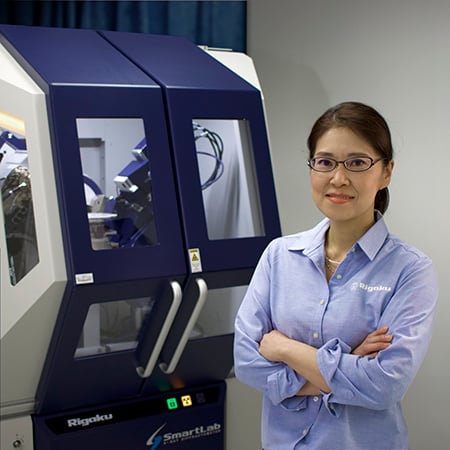MiniFlex Office Hour Episode # 8 Recap
Oct 27, 2025

Recap provided by Aya Takase
Thank you to everyone who joined us for Episode 8 of MiniFlex Office Hour! As always, our XRD expert, Akhilesh Tripath, shared valuable insights and answered practical questions from MiniFlex users around the world. Below is a quick recap of the key topics we covered.
You can watch the full recording here. If you’re new to MiniFlex, it’s a benchtop X-ray diffractometer that researchers have trusted since 1973.
Episode recap
-
The Rietveld method, pioneered by Dr. Hugo M. Rietveld, is the go-to technique for quantitative analysis of powder diffraction data. Unlike older methods that focused only on peak integrated areas or intensities, the Rietveld method uses all data points in the entire powder pattern (also known as "whole powder pattern fitting").
A typical Rietveld analysis process involves several key steps:
1. Data collection:
- Collect high-quality data over a sufficient 2θ range. For example, in mineralogy, this might be 3° to 90°, or for organic materials, 2° to 50° or 60°, since intensity often starts dying down beyond that range.
- Ensure good counting statistics (scan slow enough to achieve a high signal-to-noise ratio) and good resolution (use a small step size to resolve peak profiles correctly).
2. Initial modeling:
- Identify all phases in the sample. This requires using a database (such as ICDD, COD, or ICSD) that contains crystal structure information. This identification provides the initial structural model to simulate the entire diffraction pattern.
3. Refinement:
- The SmartLab Studio II Rietveld program combines several mathematical functions (such as background, profile shape, scale, and zero point), in addition to the crystal structure information, to create a calculated pattern.
- This calculated pattern is overlaid onto the measured pattern collected from the diffractometer.
- The program minimizes the differences between the calculated and measured patterns over several refinement cycles by refining the variables of these functions.
- Once the model reaches the global minimum, meaning the calculated pattern is very close to the measured pattern, the user can obtain results, including quantities of each phase, unit cell parameters, or even bond lengths, bond angles, and occupancies of an atomic position.
-
For a complex, multiphase sample, the success of a Rietveld refinement hinges on the user guiding the non-linear least-squares fitting toward a global minimum, avoiding getting stuck in a local minimum, which can yield wrong results despite seemingly good fitting parameters.
For a typical refinement, the recommended order of parameters to check and refine is:
- Background and scale factors.
- Zero point or sample displacement.
- Lattice parameters.
- Profile parameters (or peak shape functions), such as the pseudo-Voigt function.
-
Refining structural parameters, such as the atomic positions, occupancy, and thermal parameters, should be approached with extreme caution, particularly when using standard lab data.
- When to refine: Synchrotron-quality data (which offers orders of magnitude higher X-ray counts than lab data) is recommended for tinkering with atomic parameters, especially if the project involves atomic substitution.
- Caution with lab data: Lab data is often not sufficient, and refining these structural parameters just to achieve lower values for mathematical parameters can result in a senseless refinement.
- Verification: If you do refine structural parameters, you must check the bond lengths and bond angles. These values should never change significantly or go outside the expected range for each type of bonding.
- Data sensitivity: Ensure the diffraction pattern is sensitive to the atom you are interested in. For example, adjusting the X-ray energy close to an atom's absorption edge at a synchrotron can increase sensitivity to that atom's location or occupancy. Note that X-ray diffraction patterns are not sensitive to light elements, such as hydrogen, and neutron diffraction is required to enhance the sensitivity.
- Best practice: When refining atomic parameters or occupancies, refine one parameter at a time and check whether the diffraction pattern is sensitive to that parameter's change.
-
Adding constraints and restraints is crucial when using limited data or when varying many parameters, especially the atomic parameters, to avoid overfitting and generating meaningless numbers.
- Restraints: These are related specifically to bond lengths and bond angles. They keep the atomic structure in a realistic range.
- Constraints: These relate to symmetry relationships, occupancies, and chemical relationships. For example, when studying atomic substitution (e.g., Ge substituting Si), a mandatory constraint is that the total occupancy must be 1 (or 100%). If you fail to add this constraint, you might get a mathematically refined occupancy that is nonsensical, such as the total of Ge and Si occupancies exceeding 100%.
-
Several indicators signal that your Rietveld model has a problem, rather than just requiring further fine-tuning:
- Unindexed peaks: If you missed one of the phases when setting up the model, that missing phase will appear as unindexed peaks. The model cannot successfully fit a peak if you have not supplied the corresponding phase. Each peak is simulated based on the square of the structure factor of the phases included in the model.
- Poor or uneven difference pattern: Every Rietveld refinement provides a difference pattern plot. This shows the difference between the simulated and measured diffraction patterns. If the differences are minimized, this plot should look almost like a straight line (a flat line, though noisy). If there are large peaks or valleys in the difference pattern, this indicates missing peaks or incorrect intensities left over between the calculation and the experiment. This is a sign that you missed a phase, or added a non-existing phase, or the peak intensities are not fitting well due to preferred orientation or coarse crystal grains.
- Large estimated standard deviations (ESDs): If the model has not converged and is stuck in a local minimum, or the diffraction pattern is not sensitive to a particular fitting parameter, the parameter often shows very large ESD. Huge ESDs are a clear indication that the model is not good, or you should not be refining that particular parameter.
- Mismatched intensities: Intensities that do not match the calculated pattern may point to issues like preferred orientation (e.g., highly oriented phases like gypsum) or coarse crystal grains. The refinement must account for the preferred orientation. Or, the sample needs to be ground more.
- Poor goodness of fit (S) or R-factor (RWP): While many people focus on the RWP value (8% to 12% is often considered sufficient), indicators such as the goodness of fit, S, (which should ideally be close to 1, but up to 2 or so is acceptable) can signal problems if the value is large. A large S indicates that you are refining too many parameters.
-
If the MiniFlex were to leave a time capsule message for scientists 50 years in the future, it would convey a hope regarding the analysis of materials from space. The message would express the wish to be around to analyze materials from Mars or other planets. So the message can say something like, "Take me to Mars, and let me analyze their materials!"


Subscribe to the Bridge newsletter
Stay up to date with materials analysis news and upcoming conferences, webinars and podcasts, as well as learning new analytical techniques and applications.

Contact Us
Whether you're interested in getting a quote, want a demo, need technical support, or simply have a question, we're here to help.
